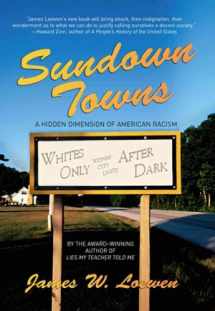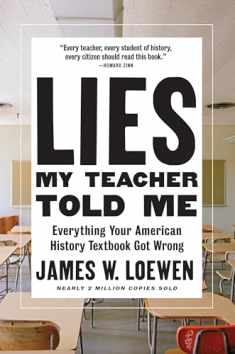
Sundown Towns: A Hidden Dimension Of American Racism
ISBN-13:
9781565848870
ISBN-10:
156584887X
Edition:
57524th
Author:
James W. Loewen
Publication date:
2005
Publisher:
New Press, The
Format:
Hardcover
562 pages
Category:
African History
FREE US shipping
Book details
ISBN-13:
9781565848870
ISBN-10:
156584887X
Edition:
57524th
Author:
James W. Loewen
Publication date:
2005
Publisher:
New Press, The
Format:
Hardcover
562 pages
Category:
African History
Summary
Sundown Towns: A Hidden Dimension Of American Racism (ISBN-13: 9781565848870 and ISBN-10: 156584887X), written by authors
James W. Loewen, was published by New Press, The in 2005.
With an overall rating of 3.5 stars, it's a notable title among other
African History
books. You can easily purchase or rent Sundown Towns: A Hidden Dimension Of American Racism (Hardcover) from BooksRun,
along with many other new and used
African History
books
and textbooks.
And, if you're looking to sell your copy, our current buyback offer is $0.3.
Description
The explosive story of racial exclusion in the north, from the American Book Award-winning author of Lies My Teacher Told Me
As American as apple pie:
• Most suburbs in the United States were originally sundown towns.
• As part of the deepening racism that swept through the United States after 1890, town after town outside the traditional South became intentionally all-white, evicting their black populations with tactics that ranged from intimidation to outright violence.
• From Myakka City, Florida, to Kennewick, Washington, the nation is dotted with thousands of all-white towns that are (or were until recently) all-white on purpose. Sundown towns can be found in almost every state.
"Don't let the sun go down on you in this town." We equate these words with the Jim Crow South but, in a sweeping analysis of American residential patterns, award-winning and bestselling author James W. Loewen demonstrates that strict racial exclusion was the norm in American towns and villages from sea to shining sea for much of the twentieth century.
Weaving history, personal narrative, and hard-nosed analysis, Loewen shows that the sundown town was—and is—an American institution with a powerful and disturbing history of its own, told here for the first time. In Michigan, Indiana, Ohio, Illinois, Missouri, Pennsylvania, and elsewhere, sundown towns were created in waves of violence in the early decades of the twentieth century, and then maintained well into the contemporary era.
Sundown Towns redraws the map of race relations, extending the lines of racial oppression through the backyard of millions of Americans—and lobbing an intellectual hand grenade into the debates over race and racism today.
As American as apple pie:
• Most suburbs in the United States were originally sundown towns.
• As part of the deepening racism that swept through the United States after 1890, town after town outside the traditional South became intentionally all-white, evicting their black populations with tactics that ranged from intimidation to outright violence.
• From Myakka City, Florida, to Kennewick, Washington, the nation is dotted with thousands of all-white towns that are (or were until recently) all-white on purpose. Sundown towns can be found in almost every state.
"Don't let the sun go down on you in this town." We equate these words with the Jim Crow South but, in a sweeping analysis of American residential patterns, award-winning and bestselling author James W. Loewen demonstrates that strict racial exclusion was the norm in American towns and villages from sea to shining sea for much of the twentieth century.
Weaving history, personal narrative, and hard-nosed analysis, Loewen shows that the sundown town was—and is—an American institution with a powerful and disturbing history of its own, told here for the first time. In Michigan, Indiana, Ohio, Illinois, Missouri, Pennsylvania, and elsewhere, sundown towns were created in waves of violence in the early decades of the twentieth century, and then maintained well into the contemporary era.
Sundown Towns redraws the map of race relations, extending the lines of racial oppression through the backyard of millions of Americans—and lobbing an intellectual hand grenade into the debates over race and racism today.


We would LOVE it if you could help us and other readers by reviewing the book
Book review

Congratulations! We have received your book review.
{user}
{createdAt}
by {truncated_author}



